3D Truss Models
-
Giving some thought to the secondary roof tool:
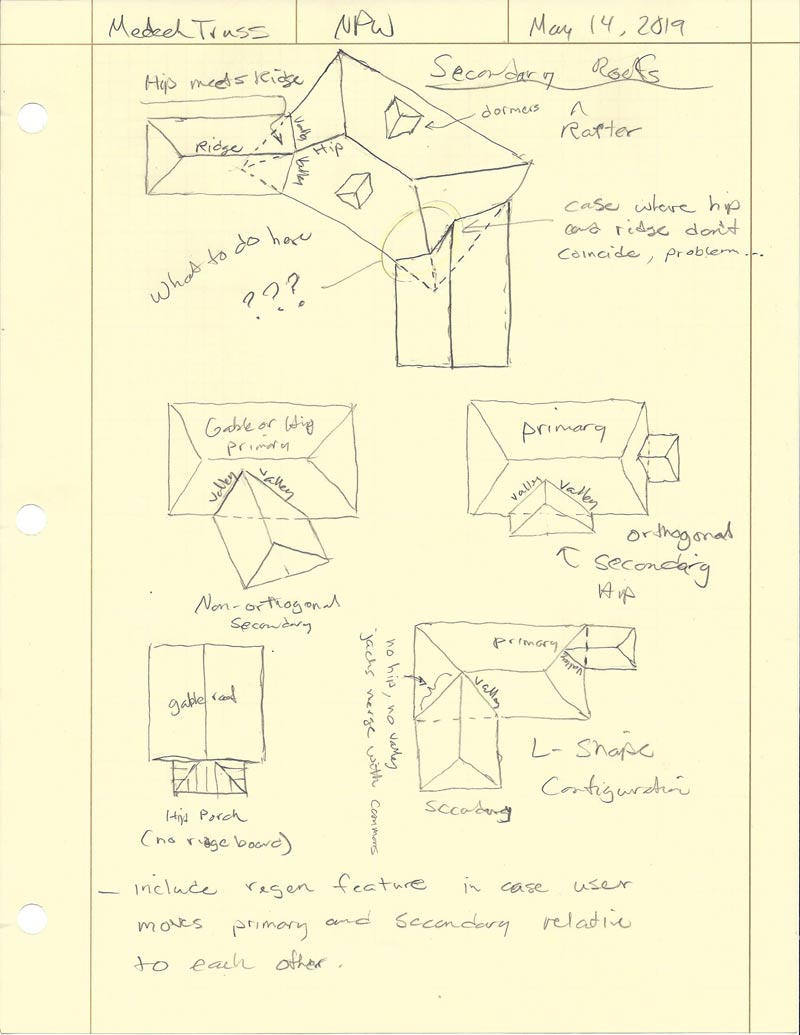
-
Trying to come up with an intuitive method for specifying a secondary roof. My idea is for the user to select the wall corners (1) and (2) that the projecting (secondary) roof will be bearing on and then to select the roof plane of the primary roof that the secondary roof should intersect. Essentially three points/picks will specify the secondary roof.

When a secondary is created it will store the primary roof name it is intersecting with as well as the roof plane. Either of these can then be modified in the secondary roof menu in the case that the user wants to switch to a different primary roof or a different roof plane of a given primary roof.
When a secondary roof is edited or regenerated it will then re-analyze the entire geometry with the specified primary roof and roof plane in order to generate the secondary roof geometry. This will allow the user maximum flexibility (ie. moving primary and secondary relative to each other {x, y, or in z} as well as changing the primary).
Orthogonal intersections are nice but we can't count on them so from the get go the secondary tool will be designed with any arbitrary intersection angle in mind as well as intersections with a roof planes or gable ends of a gable roof (wall).
Additionally, the secondary roof may be symmetric or asymmetric so it makes sense to also allow for this possibility as well.
One could even go so far as to allow for intersection with more exotic primary roofs (eg. gambrel, arched, polynesian etc...) however at this point I think I will limit myself to just a single pitched roof plane or wall plane.
There will be a separate tool for secondary hips and one for secondary gables, the reason being the vast number of different parameters required for each type of roof and the different algorithms required as far as calculating the actual roof rafter geometry.
At this point I am mostly conceptualizing and trying to see if there are any major holes or flaws in this system or method of secondary roofs. I would be interested to hear your feedback on the matter and especially if you can see any major problems with my methodology, or have suggestions for something that may work even better.
As can be seen on my previous notes page (May 14), there are a few special cases that will also need to be dealt with:
1.) Secondary roof is non-orthogonal to the primary roof and its ridge coincides or meets a primary hip. In this case the secondary really should intersect the two planes on each side of the primary's hip.
2.) A hip roof secondary meets a gable wall such that the aspect ratio of the secondary precludes it from having a ridge board perpendicular to the gable wall. There is also potentially the non-orthogonal possibility but this would not be very common.
3.) Typical L-shaped hip roof where the valley and hip theoretically merge into a common roof.
If I can somehow pull this one off, it will be a bit of a game changer for the Truss plugin since it will then allow for much more complicated rafter roofs.
-
Before I fully dive into the secondary roof module I thought it might be interesting to return to the soffit and fascia discussion I was having back in 2017. It would be nice to have soffit and fascia added to the hip rafter roof modules.
However as I am reviewing my notes and previous posts I came upon one unresolved question.
Should the roof sheathing extend out over the fascia board or should it terminate at the sub-fascia as shown in this detail:

The reason this becomes an issue is that the calculations of an asymmetric hip roof factor in the width of the sub-fascia in order to line them up around the roof. If the sheathing extends pasts the sub-fascia to the fascia then the gutter line will drop a different amount for each roof plane depending on the pitch. However if the sheathing only extends to the extent of the sub-fascia then the calculations for the roof do not need to take into account fascia width.
I can have it work either way but I would like to focus on the most common configuration.
-
Version 2.3.8 - 05.16.2019
- Fixed a bug with the pitch and area callouts for asymmetric gable rafter roofs.
- Fixed a bug with the back/rear outlooker length for gable rafter roofs which now allows for a building or roof length that is a non-integer multiple of the rafter spacing.
- Added the option in the gable rafter roof edit menu to specify a separate front and back overhang length.
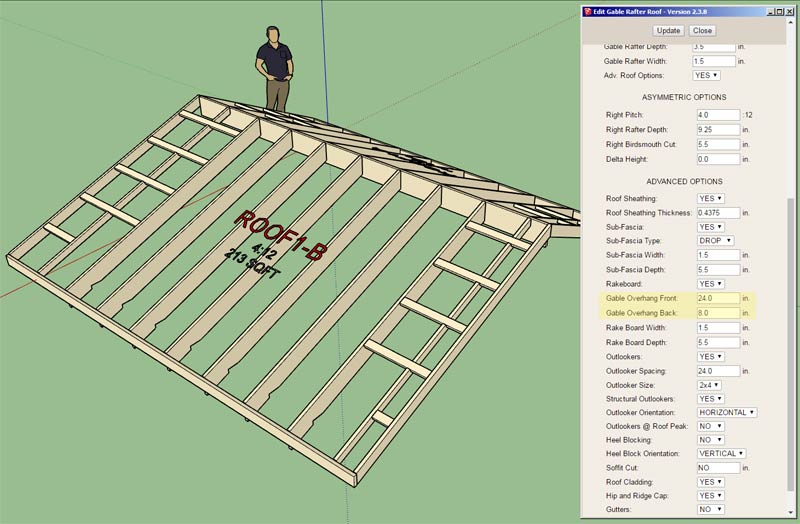
The issue with the rear outlooker length will also need to be addressed for truss assemblies.
I should also make the option for the separate front and back overhang length available for trusses as well. Lots of little things as well as big things to do.
The consensus seems to be that the sheathing should terminate at the sub-fascia and not extend over the fascia, especially if the rafter tail is a plumb cut (fascia is vertical). However, this preference also seems to be highly dependent on the particular application and type of fascia used.
Here is another interesting detail:

-
A few other things to note with regards to fascia and soffit:
1.) In order to enable soffit and fascia the advanced options must be turned on and the sub-fascia option must also be turned on.
2.) The consensus appears to put the fascia top flush with the sub-fascia top with the sheathing terminating at the outside edge of the sub-fascia.
3.) Gutter placement will then be unaffected by the fascia other than be offset by its thickness.
4.) The soffit will be placed level to the horizontal and extend to the outside edge of the sub-fascia meeting the fascia and to the wall sheathing. Since the plugin is not keeping track of what walls are being used (Medeek, Framer, or a simple solid), there will be a wall sheathing offset parameter that will allow the user to control this offset. I've noticed some details showing the soffit extending to the framing, others to the sheathing and still others to a brick or stucco layer.
5.) The soffit top surface will abut the underside of the sub-fascia.
6.) Materials for soffit and fascia will both be user driven/customizable.
7.) Parameters to include: Soffit thickness, Fascia thickness, Fascia depth.
8.) I will also be adding in an additional parameter for the roof cladding which allows the user to extend it beyond the sheathing a specified amount (Roof Cladding Extension). This will naturally extend the ridge or hip caps the appropriate amounts as well.
I realize there are other soffit variations but I will be starting with the flat soffit first and then consider the angled soffit in future developments.
-
Version 2.3.9 - 05.17.2019
- Enabled a roof cladding extension parameter for all hip rafter roofs.
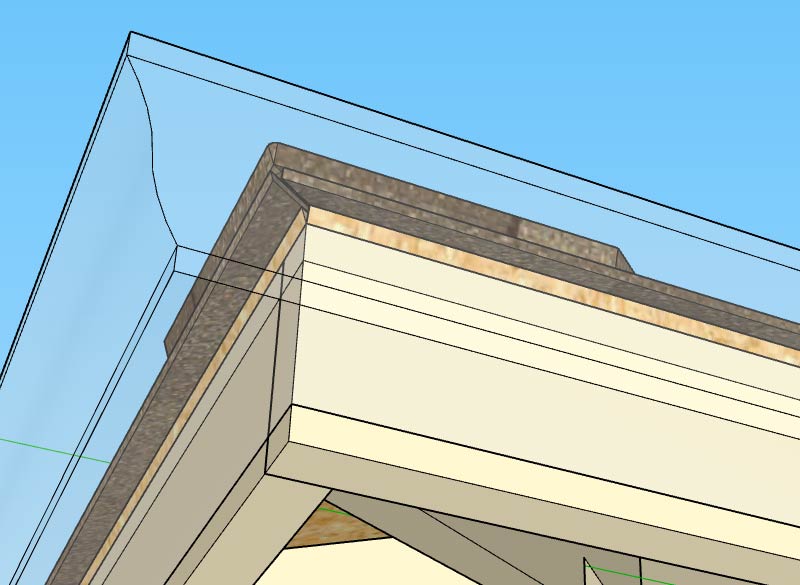
The extension is measured inline with the roof plane (not with the horizontal).
-
First look at the soffit and fascia (hip roof):
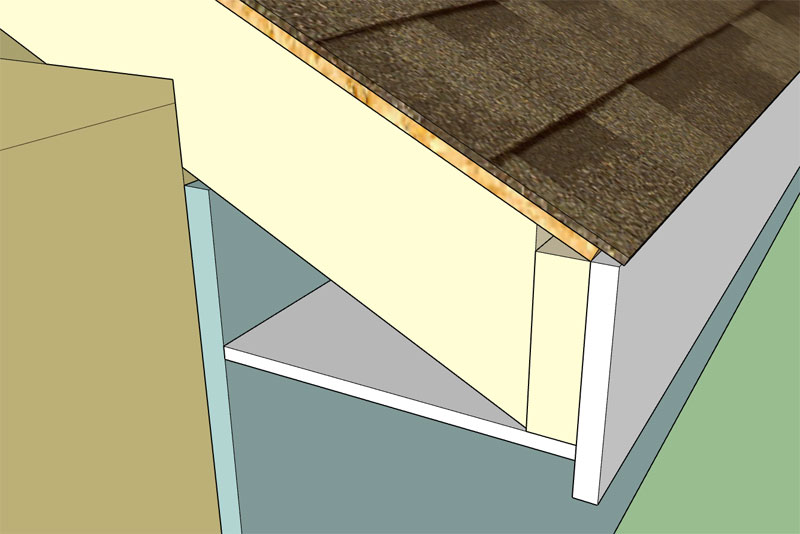
Also note the roof cladding extension (3/4") with a 6:12 pitch.
-
Version 2.4.0 - 05.19.2019
- Enabled soffit and fascia for all hip rafter roofs.
- Fixed a minor bug with the ridge cap extension for asymmetric hip roofs.
- Enabled custom materials for roof sheathing and roof cladding in the HTML edit menu for all hip rafter roofs.
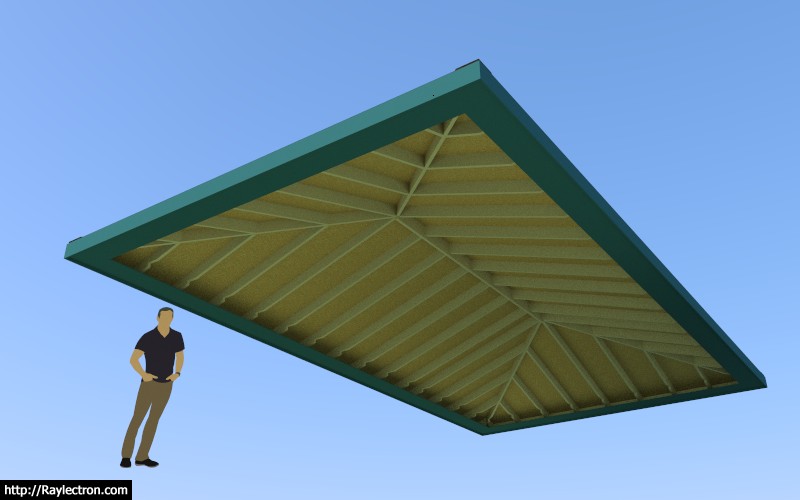
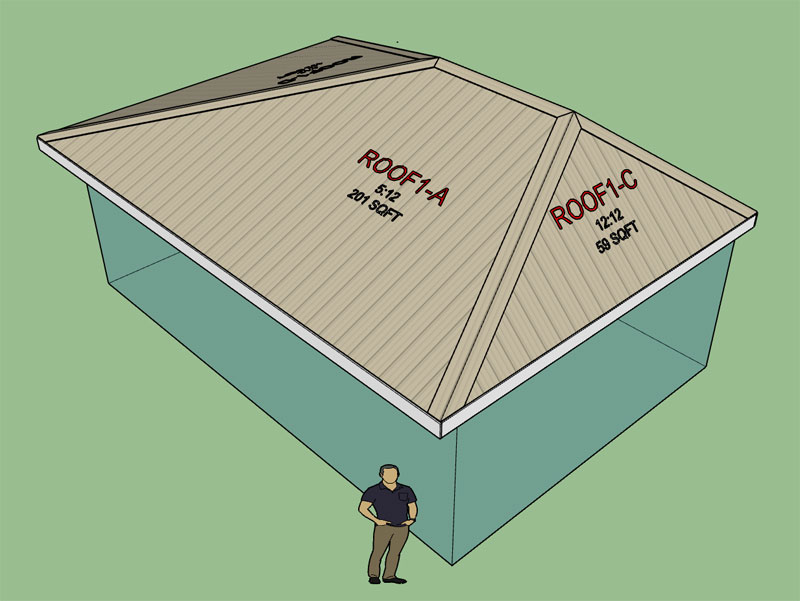
Custom materials is also enabled for both the soffit and the fascia. Soffit and fascia can only be specified in the edit menu once the roof is created. The current draw menu presents the user with far less parameters and will be updated to a more advanced HTML menu in the future.
Once I am satisfied with the soffit and fascia with the hip roofs I can then extend it to gable, shed and dutch gable roofs and all other truss roofs.
View example model here:
3D Warehouse
3D Warehouse is a website of searchable, pre-made 3D models that works seamlessly with SketchUp.
(3dwarehouse.sketchup.com)
-
I'm considering adding in drip edge but then again it may be a step too far?

If gutter is enabled then the drip edge is barely visible. For estimating purposes I can just calc the perimeter of the roof to get the lineal feet of drip edge. Is it worth the effort?
-
After some further testing of the roof cladding extension parameter I think it makes more sense to make the extension per the horizontal and not per the roof plane. The problems really only seem to arise when you have an asymmetric roof, in this case the higher pitched roof will project less than the lower pitched roof if the extension is parallel to the roof plane.
Thoughts?
-
The two most common drip edges I've seen applied to residential roofs are the right two profiles shown in this image:
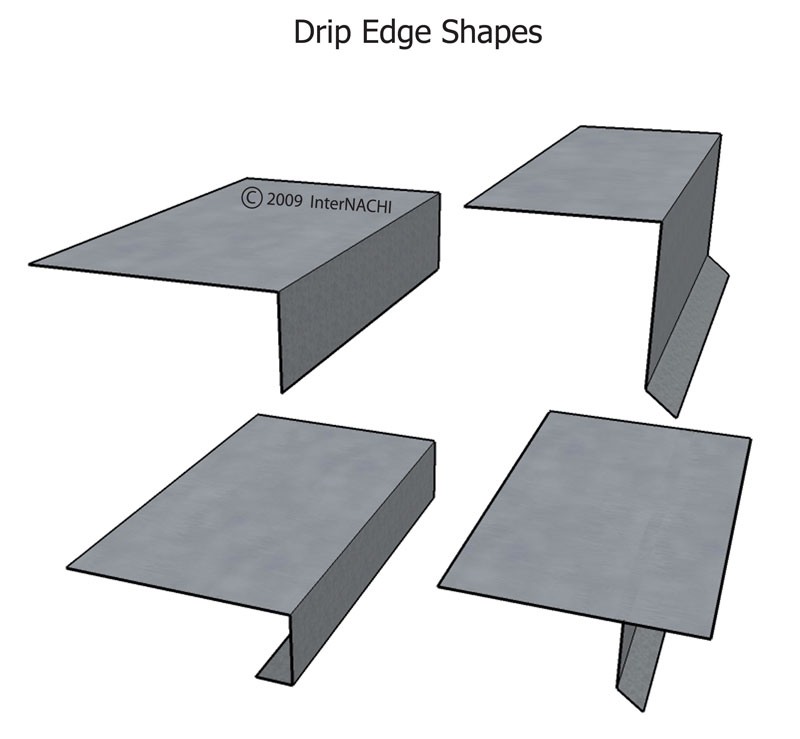
It would be more light weight to represent these metals as simple edges and faces but then they would Z fight with whatever they are resting on so I guess it is probably better to assign a thickness and model them as a solid instead.
So the two options to start will be a L or a D drip edge (not sure why they call it a D). The dimensions will all be customizable like the roof gutters.
-
I've decided to put the drip edge on hold for just a bit and focus on the secondary roof module.
There is really two ways to handle this. You can either start with a primary roof and then add secondary roofs that tie into it. Or you can allow the user to pick the building outline (any polygon) and utilize a straight skeleton algorithm to compute the roof planes. There are some pros and cons (limitations) to each method.
Obviously with the straight skeleton method one would assume that the fascia lines up all the way around the roof so it doesn't lend itself to secondary roofs like dormers that may be positioned up on the roof.
However, the straight skeleton allows for some really complicated scenarios that you just cannot achieve with a secondary roof methodology.
A few months ago I was trying to come up with a robust straight skeleton algorithm and somehow it defeated me. This morning I took a slightly different approach and I now think I've finally solved it:
Step 1:
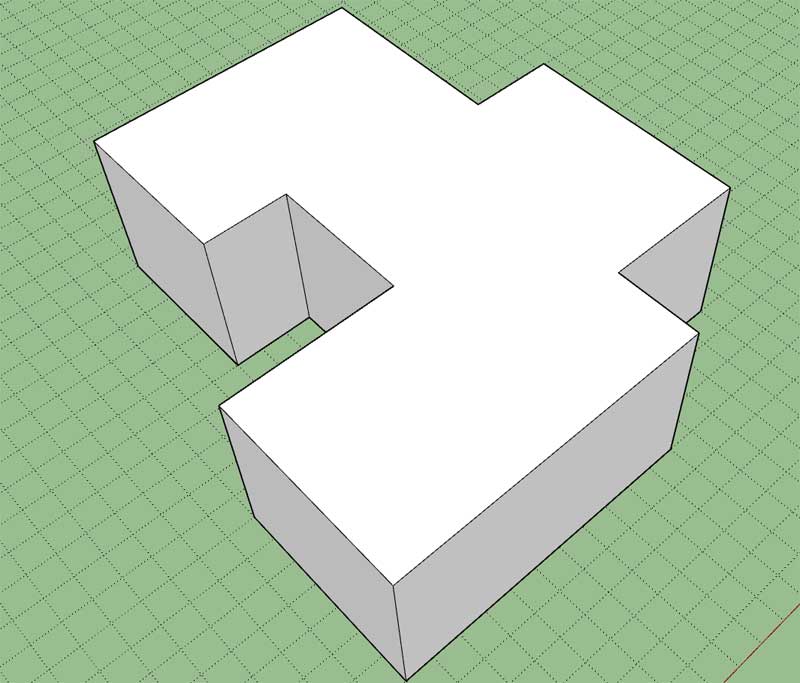
Step 2:
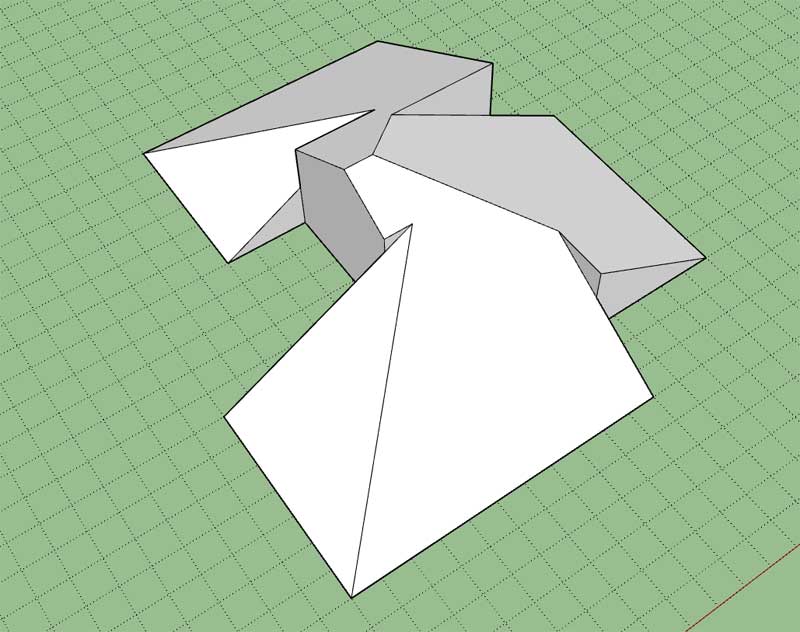
Step 3:
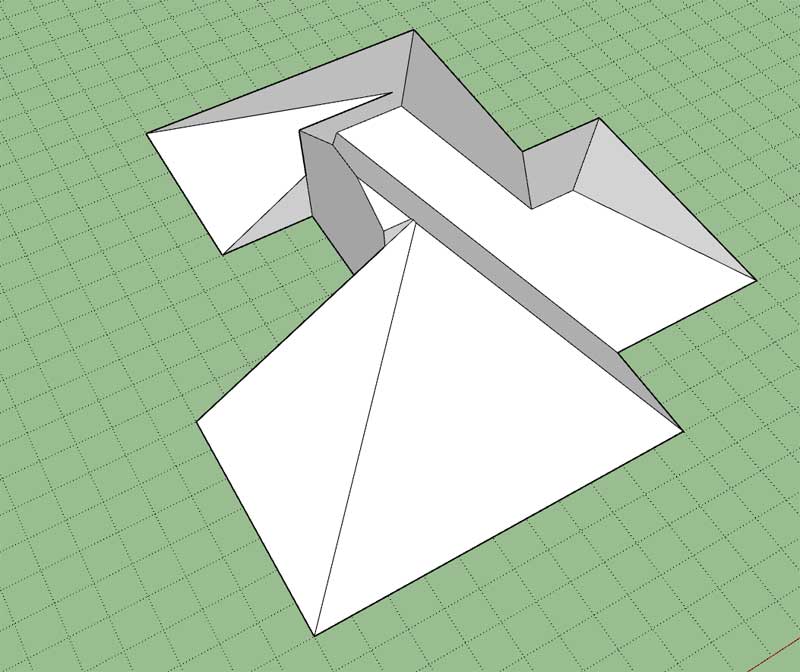
Step 4:
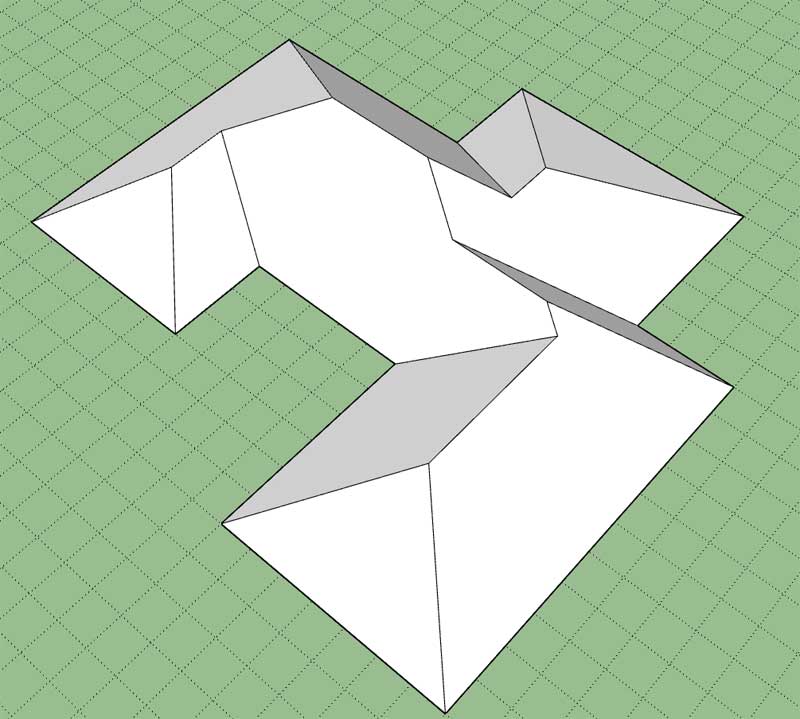
Once I have the roof "solid" I can then easily pull out the edges that represent the hips, ridges, valleys and flying hips. From there it is just a matter of some tedious logic to detect whether to frame a common, hip jack, valley jack or cripple jack (hip/valley jack).
Of course the devil is in the details but I now think I have a path forward for complex roofs, this is major breakthrough.
-
I will also need a tool or function that allows the user to toggle specific roof planes from hip to gable or back again.
-
The complex roof algorithm seems to be fairly robust thus far, I haven't been able to break it just yet. However as I am contemplating how to make it so that each roof plane is adjustable (variable pitch) it is quickly becoming apparent that such a feature would become very complicated.
The issue really is a situation where you have a particular roof plane that you want to adjust. You then change its pitch (assuming all other pitches are left the same) and the roof gets recalculated. In certain situations that roof plane may then merge with another roof plane. If that happens then one of the two roof planes is absorbed by the other (both pitches must be equal of course).
The difficulty seems to arise in the tracking of each roof plane and the custom pitch assigned to it. The number of roof planes can be variable. The ability to edit each roof plane will need to be an "on the fly" sort of tool which allows the user to adjust only one roof plane at a time and then recalc the entire roof to re-determine the shape of the roof and hence how many and where its new roof planes actually are.
The easiest way to store this information, in my option. is to maintain the roof solid group (on a separate hidden layer). From this solid the roof planes can quickly be ascertained as well as the outline or footprint of the roof. I'm still thinking this one through as you can probably tell.
Initially the roof will be drawn with one overhang and one pitch. Where the edit menu can take it from there is where it potentially becomes quite complicated.
Consider a complex roof like the one below:
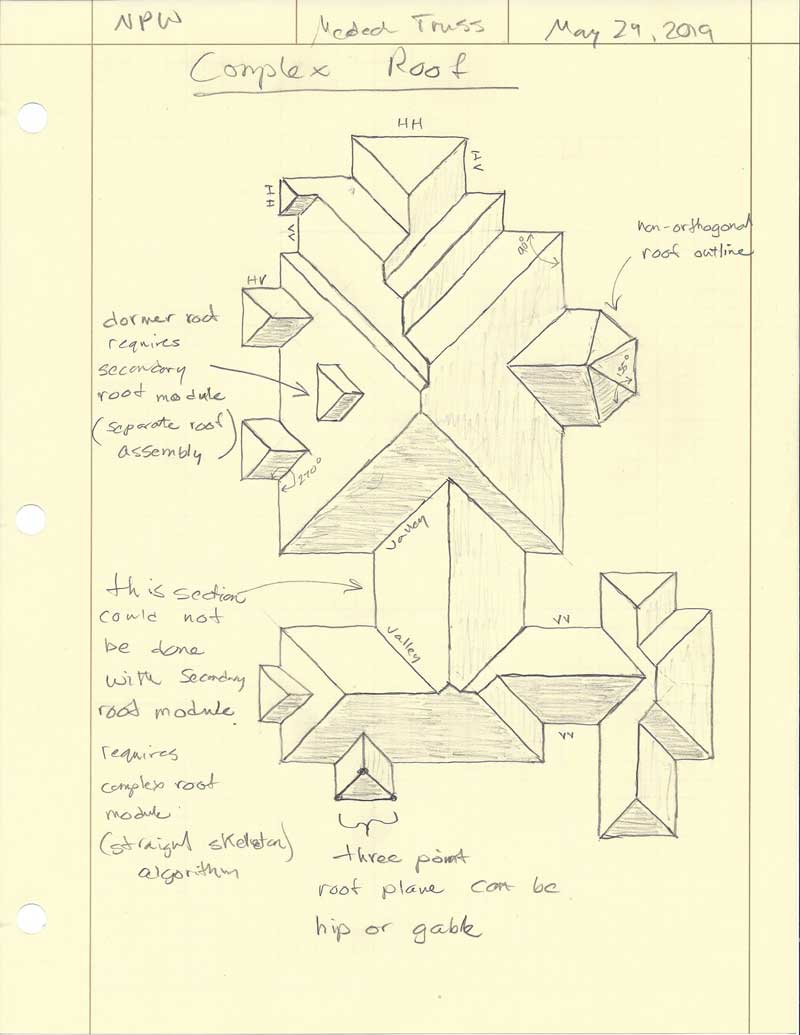
I can see that the framing can be accomplished with some basic rules/logic however non-orthogonal roof outlines will probably require some additional logic.
The tool that allows the user to define the footprint or outline of the roof should allow for the selection of a face or allow the user to pick points that then define the closed path of the roof outline. The code required to do this is already within my foundation plugin and will only need some minor modifications to make if work for this module as well.
-
Version 2.4.1 - 05.25.2019
- Parameter hightlight (input) color added to General tab of global settings.
- Parameter change highlighting enabled for the gable and hip rafter roof edit menus.
- Added the indexing parameter for roofs and floors to the General tab of the global settings.

A few minor items addressed per recent customer requests.
-
Since the hip rafter roof now has soffit and fascia I thought it would be fitting to add the same treatment to the gable roof, however the gable roof is surprisingly more complicated when it comes to soffit and fascia. Take the example shown below:
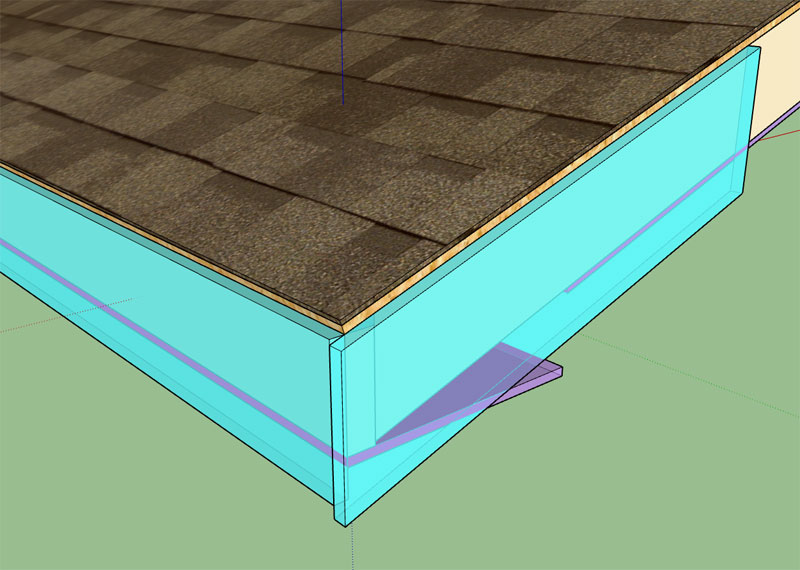
A number of questions arise:
1.) The sheathing terminates at the sub-fascia (at the eave, per previous discussion) however should it extend out to the gable fascia? or just terminate at the gable sub-fascia as shown?
2.) The cladding may need a different treatment even for hip roofs and for gable roofs. Rather than relying on the cladding extension parameter to bring it out over the fascia maybe bring the cladding out to the fascia by default and then the extension parameter brings it beyond the fascia if desired? The cladding extension parameter should also really be per the horizontal rather than per the roof plane due to complications with asymmetric roofs.
3.) A number of possible configurations can exist at the corner where the eave and gable soffit meet. Ideas? I don't even know what these variants are called, but I've seen them all. Some architects really don't like the soffit boxes but even these are popular in many regions.
4.) Should the gable fascia terminate as shown or extend beyond the eave fascia (projection). The projected gable fascia seems to be very popular in western Washington.
5.) The gutters will naturally be offset if fascia is specified but should I extend the gutters to terminate flush to the gable fascia or leave them so they terminate flush to the gable sub-fascia?
These roofs are complicated business. Lots of little details. Even though I'm not an architect or designer I've still got to deal with them all since I'm creating a tool that involves all of these subtle design decisions. Structural elements tend to be a bit simpler in my opinion.
-
I really have no idea if this is the correct way to build a soffit box but here is one possibility:
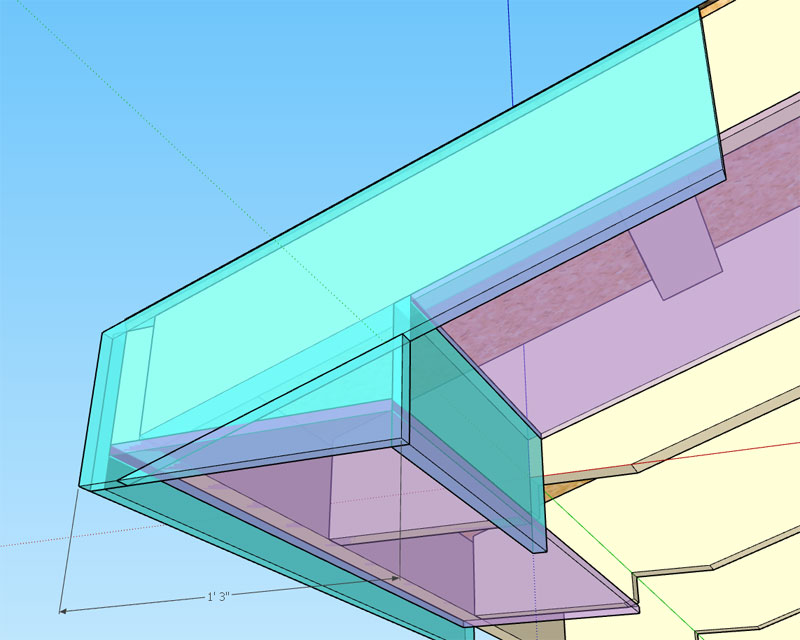
A couple things jump out at me:
1.) Note the double miter cut of the gable fascia.
2.) Note the addition of the two pieces of fascia to create the soffit box.
3.) I've shown this soffit box with a 15" return (the minimum return) however one could extend the return further and the eave soffit would then morph into an L shaped configuration. So if this type of soffit configuration is specified I should also provide the user with the ability to set the return length.
With gable roofs and their soffit and fascias it looks like I've open yet another can of worms.
-
Here is a soffit box with an extended return (4"):
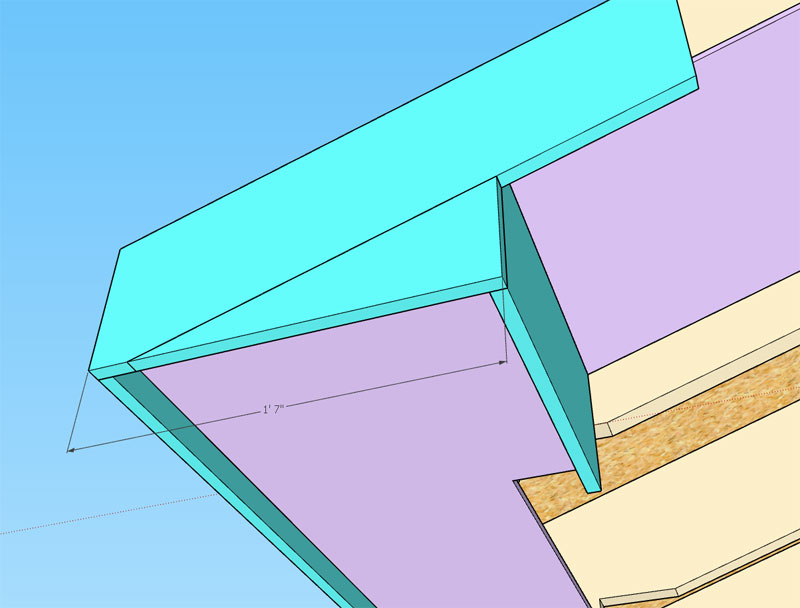
Note the L-shaped eave soffit.
-
Version 2.4.2 - 05.27.2019
- Enabled soffit and fascia for gable rafter roofs.
- Enabled a roof cladding extension parameter for gable rafter roofs.
- Enabled custom materials for roof sheathing and roof cladding in the HTML edit menu for gable rafter roofs.
- Added the soffit box extension parameter for gable rafter roofs.
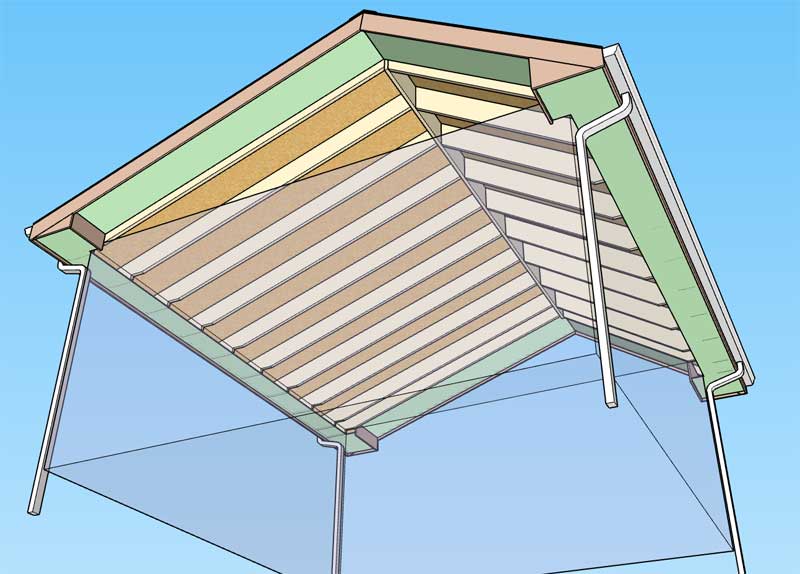
View model here:
3D Warehouse
3D Warehouse is a website of searchable, pre-made 3D models that works seamlessly with SketchUp.
(3dwarehouse.sketchup.com)
Note the trimming of the ridgeboard if required.
Currently there is only one way to soffit and fascia the gable roof but if there is enough call for it I can also look at this type of configuration:
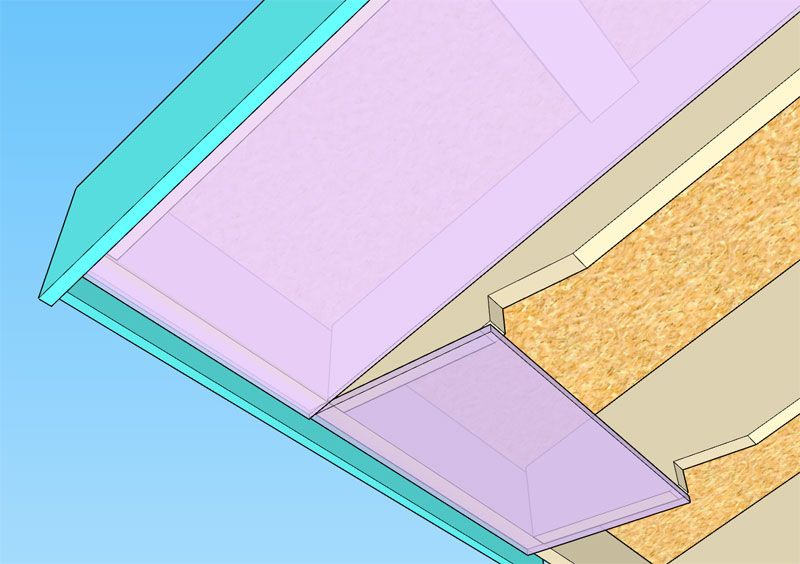
-
The other configuration I've noticed being used quite a bit locally is the angled soffit:
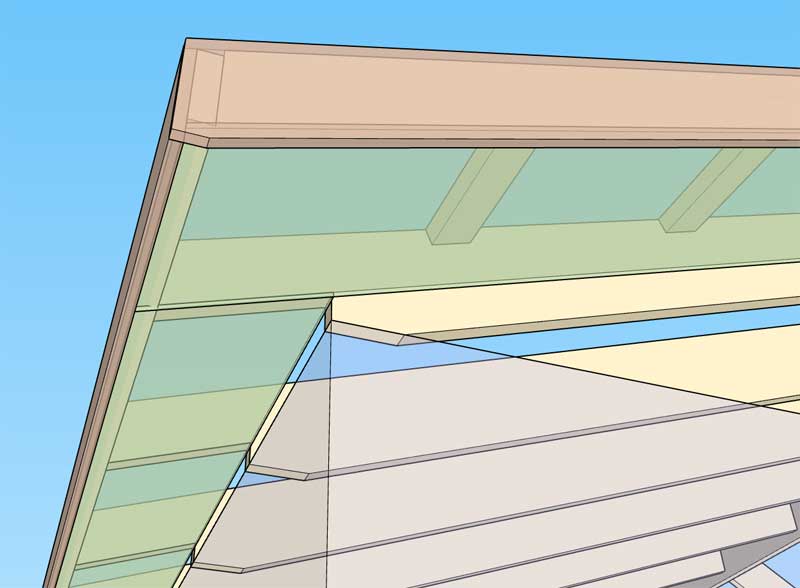
Personally I think this type of soffit works better where the rafter tails are square cut and not plumb cut otherwise the sub-fascia will probably need to be adjusted (beveled) on its bottom to ensure that the soffit fits correctly.
The one thing to note with this arrangement is that the gable soffit and eave soffit should be coplanar. In order for that to happen the depth of the rafter tails must equal the depth of the rake board (barge rafter). One way to achieve this if the rafters are quite deep is to trim them as shown in the image. An alternative approach is to match the barge rafter with the actual rafters but this will result in a very deep/thick fascia and a heavy look.
I'm just thinking out loud here so correct me if I'm seriously mistaken with any of my musings. The angled soffit is certainly another option that I could add in but I need to make sure there is call for it and that I've got it right.
Advertisement









